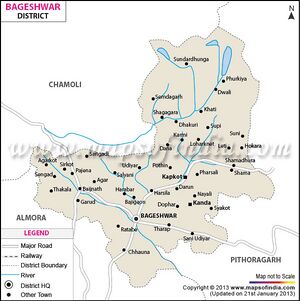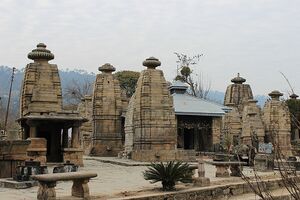Baijnath Uttarakhand
| Author:Laxman Burdak, IFS (R) |


Baijnath (बैजनाथ) is a small town on the banks of the Gomati River in the Bageshwar district of Uttarakhand, India. The place is most noted for its ancient temples,[1] which have been recognized as Monuments of National Importance by the Archaeological Survey of India in Uttarakhand.[2]
Location
Baijnath is located at 29.92°N 79.62°E, 20 km northwest of Bageshwar city, in Bageshwar district in Uttarakhand. It has an average elevation of 1,130 metres (3,707 feet). Baijnath is situated in the Katyur valley of the Kumaon Himalayas at the left bank of Gomati river. Nearby villages include Dangoli, Gagrigol, Haat, Teet Bazar, Purara, Noghar, etc.
Variants
- Baijnath Uttarakhand बैजनाथ, जिला बागेश्वर, उत्तराखंड, (AS, p.646)
- Kartikeyapura (कार्तिकेयपुर)
History
Baijnath, formerly known as Kartikeyapura, was capital of Katyuri kings[3] who ruled over an area consisting of combined parts of Garhwal and Kumaun in modern-day state of Uttarakhand, India and Doti in Modern day Nepal.
The first permanent settlement of the area was a town named Karvirpur or Karbirpur.[4][5] The ruins of this town were used by Katyuri King Narsingh Deo to establish his capital in the area.[6][7]
The earliest ruling dynasty of Garhwal known is of the Katyuris. The Katyuri Raja of Uttarakhand (Kumaon and Garhwal) was styled 'Sri Basdeo Giriraj Chakara Churamani'. The earliest traditions record that the possessions of Joshimath Katyuris in Garhwal extended from Satluj as far as Gandaki and from the snows to plains, including the whole of Rohilkhand. Tradition gives the origin of their Raj at Joshimath in the north near Badrinath and subsequent migration to Katyur Valley in Almora district, where a city called Kartikeyapura was founded.[8]
Baijnath remained the capital of Katyuri Dynasty, who ruled the area from 7th-13th century AD., it was then known as Kartikeyapura. The katyuri kingdom then consisted of combined parts of Garhwal and Kumaun in modern-day state of Uttarakhand, India and Doti in Modern day Nepal.
Nepalese invader Kranchaldev invaded Baijath in 1191, and defeated the Katyuri kings[9] The weakened Katyuri Kingdom later disintegrated in the 13th century giving rise to 8 different princely states. Baijnath remained under the rule of Baijnath Katyurs,[10] descendants of Katyuri kings, till 1565 until king Balo Kalyan Chand of Almora annexed Baijnath to Kumaun.[11]
The Gorkhas of Nepal while expanding their kingdom westwards across Kali River, invaded and overran Almora,[12] the seat of the Kumaon Kingdom and other parts of Kumaon in 1791. In 1816, the Gorkhas were defeated by the East India Company[13] in Anglo-Nepalese War in 1814[14]and were forced to cede Kumaon to the British as part of the Treaty of Sugauli.[15]
बैजनाथ, उत्तराखंड
बैजनाथ (AS, p.646) अल्मोड़ा ज़िला, उत्तराखंड में स्थित है। यह स्थान गोमती नदी के तट पर है। यहाँ नन्दा देवी का मन्दिर और रणचूला के क़िले में काली का मन्दिर स्थित है। [16]
External links
References
- ↑ Kohli, M. S. (2002). Mountains of India : tourism, adventure and pilgrimage. New Delhi: Indus Publ. Co. p. 148. ISBN 9788173871351.
- ↑ "List of Ancient Monuments and Archaeological Sites and Remains of Uttranchal - Archaeological Survey of India". asi.nic.in.
- ↑ Imperial Gazetteer2 of India, Volume 6, p.217
- ↑ Oakley, E. Sherman (1905). Holy Himalaya: The Religion, Traditions and Scenery of a Himalayan Province (Kumaon and Garhwál). Oliphant Anderson & Ferrier. p. 98.
- ↑ Handa, O. C. (2008). Panorama of Himalayan architecture. New Delhi: Indus. p. 217. ISBN 9788173872129.
- ↑ Misra, N.N. (1994). Source materials of Kumauni history. Almora, U.P. Hills: Shree Almora Book Depot. p. 166. ISBN 9788185865249.
- ↑ Epigraphia Indica. Manager of Publications. 1982. p. 114.
- ↑ Garhwal Himalayas: A Study in Historical Perspective By Ajay S. Rawat
- ↑ Bruce, Charles Granville (8 February 2015). Twenty Years in the Himalaya - Scholar's Choice Edition. Scholar's Choice. ISBN 9781294961789.
- ↑ Kathoch, Y.S. A New History of Uttarakhand.
- ↑ "Home to ancient Katyuri culture".
- ↑ Hamilton, Francis; Buchanan, Francis Hamilton (1819). An Account of the Kingdom of Nepal: And of the Territories Annexed to this Dominion by the House of Gorkha. A. Constable.
- ↑ Lamb, Alastair (1986). British India and Tibet, 1766-1910 (2nd, rev. ed.). London: Routledge & Kegan Paul. ISBN 0710208723.
- ↑ Cross, John Pemble ; foreword by J.P. (2008). Britain's Gurkha War : the invasion of Nepal, 1814-16 ([Rev. ed.] ed.). London: Frontline. ISBN 978-1-84832-520-3.
- ↑ Cross, John Pemble ; foreword by J.P. (2008). Britain's Gurkha War : the invasion of Nepal, 1814-16 ([Rev. ed.] ed.). London: Frontline. ISBN 978-1-84832-520-3.p.594
- ↑ Aitihasik Sthanavali by Vijayendra Kumar Mathur, p.646

